Analysis of Employee Relations and HRM Articles
VerifiedAdded on 2020/07/23
|16
|5470
|37
AI Summary
This assignment requires the analysis of a list of employee relations and HRM articles, covering various topics such as workplace bullying, diversity management, organizational empowerment, and psychological contracts. The articles are sourced from reputable journals and publications, offering a comprehensive understanding of contemporary issues in employee relations and HRM. The task involves identifying key concepts, themes, and research methodologies presented in the articles, demonstrating a critical understanding of the subject matter.
Contribute Materials
Your contribution can guide someone’s learning journey. Share your
documents today.
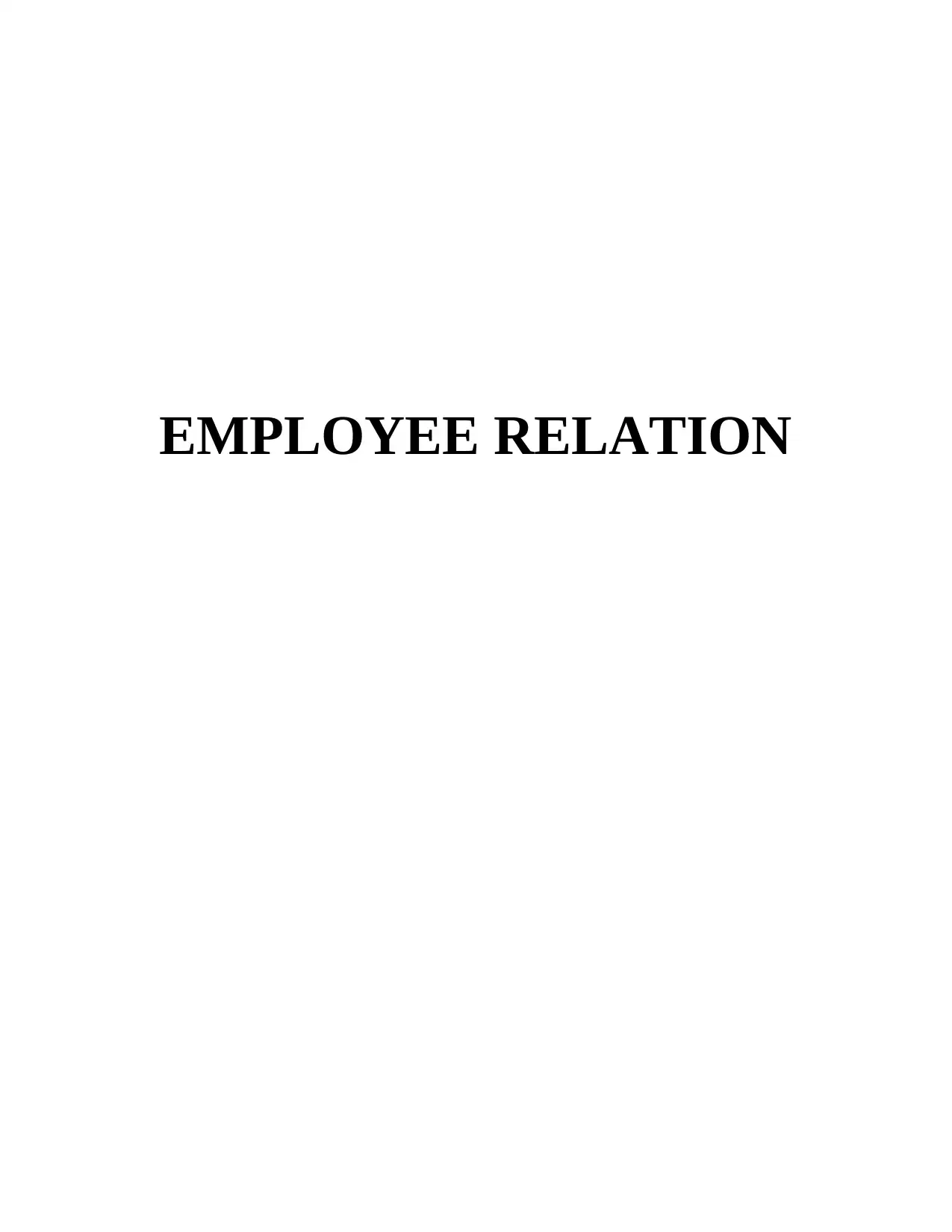
EMPLOYEE RELATION
Secure Best Marks with AI Grader
Need help grading? Try our AI Grader for instant feedback on your assignments.
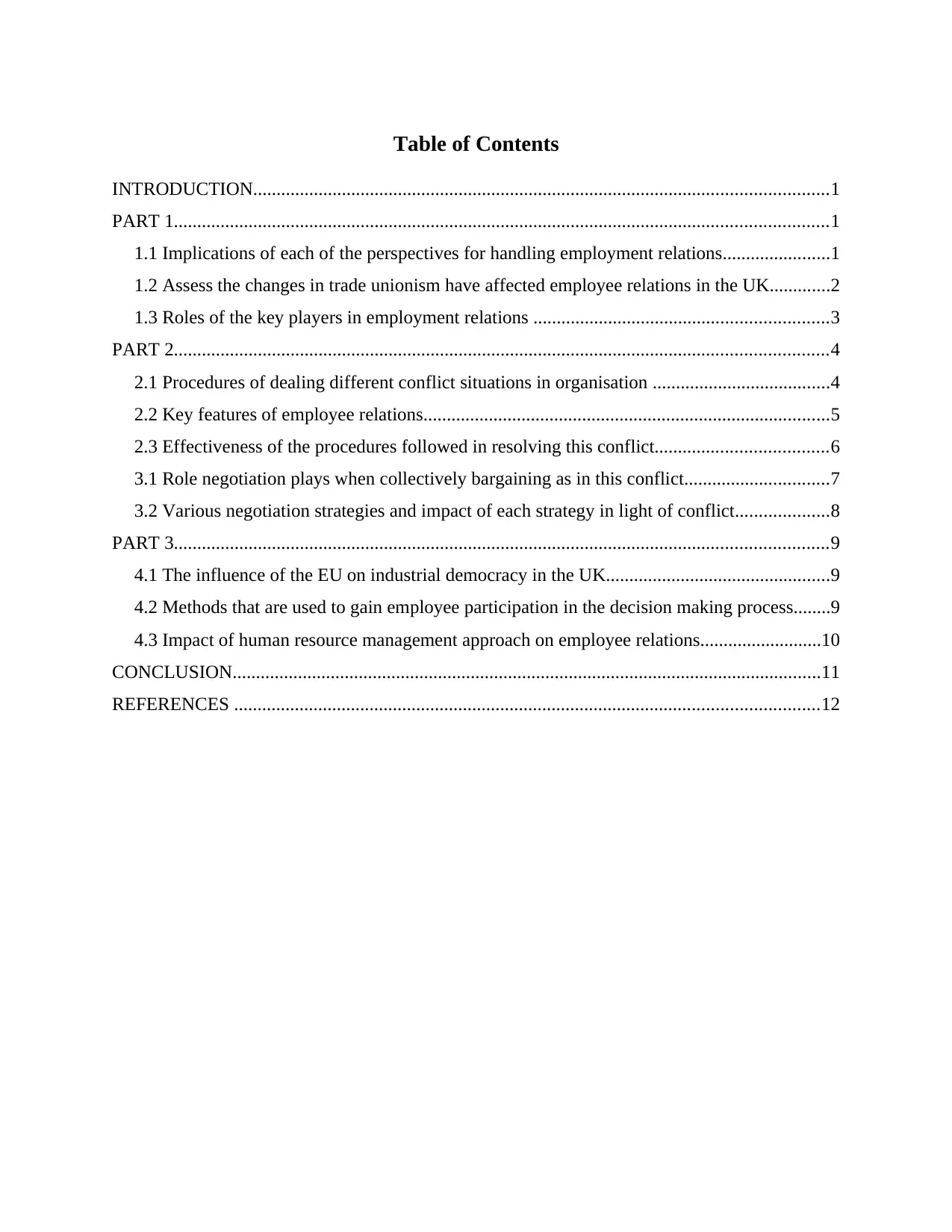
Table of Contents
INTRODUCTION...........................................................................................................................1
PART 1............................................................................................................................................1
1.1 Implications of each of the perspectives for handling employment relations.......................1
1.2 Assess the changes in trade unionism have affected employee relations in the UK.............2
1.3 Roles of the key players in employment relations ...............................................................3
PART 2............................................................................................................................................4
2.1 Procedures of dealing different conflict situations in organisation ......................................4
2.2 Key features of employee relations.......................................................................................5
2.3 Effectiveness of the procedures followed in resolving this conflict.....................................6
3.1 Role negotiation plays when collectively bargaining as in this conflict...............................7
3.2 Various negotiation strategies and impact of each strategy in light of conflict....................8
PART 3............................................................................................................................................9
4.1 The influence of the EU on industrial democracy in the UK................................................9
4.2 Methods that are used to gain employee participation in the decision making process........9
4.3 Impact of human resource management approach on employee relations..........................10
CONCLUSION..............................................................................................................................11
REFERENCES .............................................................................................................................12
INTRODUCTION...........................................................................................................................1
PART 1............................................................................................................................................1
1.1 Implications of each of the perspectives for handling employment relations.......................1
1.2 Assess the changes in trade unionism have affected employee relations in the UK.............2
1.3 Roles of the key players in employment relations ...............................................................3
PART 2............................................................................................................................................4
2.1 Procedures of dealing different conflict situations in organisation ......................................4
2.2 Key features of employee relations.......................................................................................5
2.3 Effectiveness of the procedures followed in resolving this conflict.....................................6
3.1 Role negotiation plays when collectively bargaining as in this conflict...............................7
3.2 Various negotiation strategies and impact of each strategy in light of conflict....................8
PART 3............................................................................................................................................9
4.1 The influence of the EU on industrial democracy in the UK................................................9
4.2 Methods that are used to gain employee participation in the decision making process........9
4.3 Impact of human resource management approach on employee relations..........................10
CONCLUSION..............................................................................................................................11
REFERENCES .............................................................................................................................12
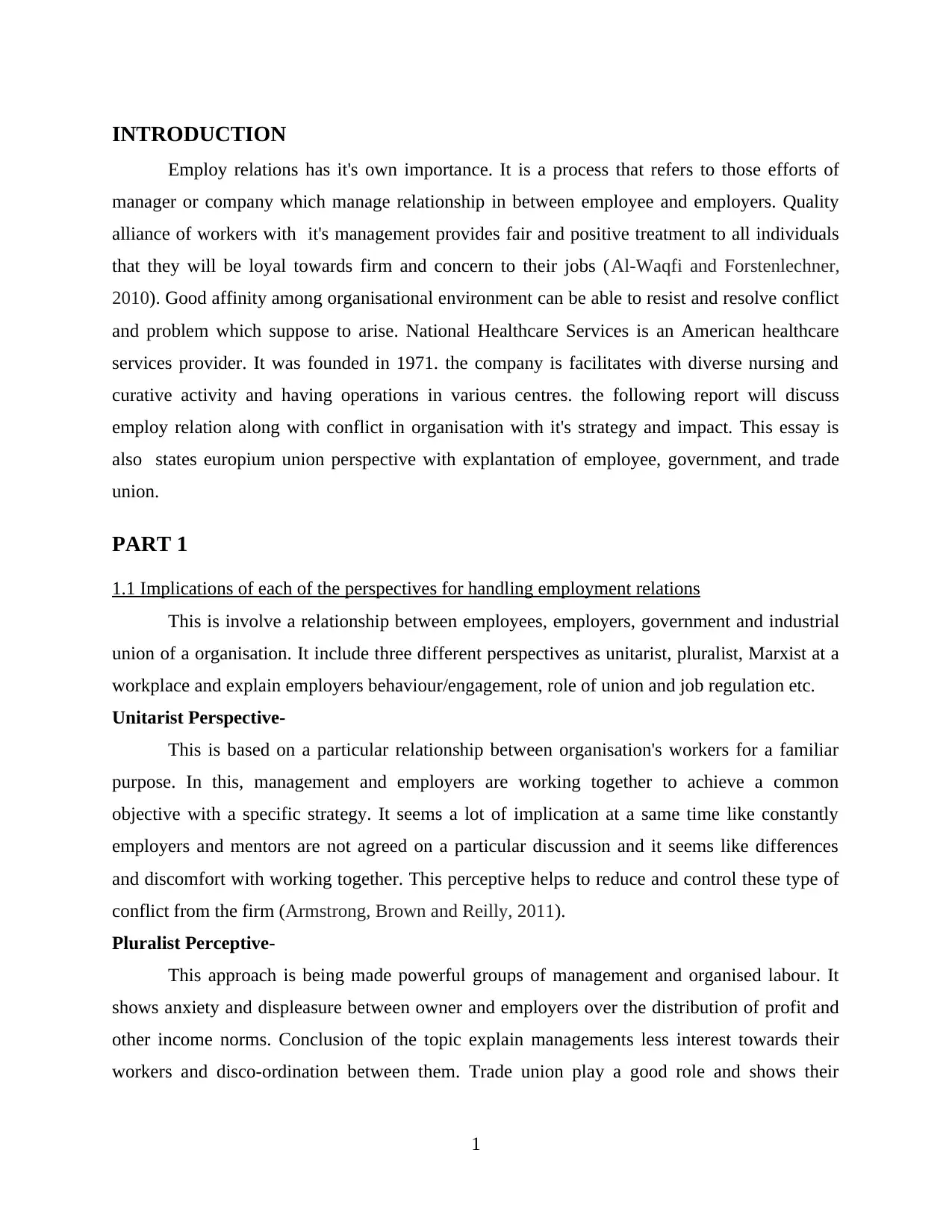
INTRODUCTION
Employ relations has it's own importance. It is a process that refers to those efforts of
manager or company which manage relationship in between employee and employers. Quality
alliance of workers with it's management provides fair and positive treatment to all individuals
that they will be loyal towards firm and concern to their jobs (Al-Waqfi and Forstenlechner,
2010). Good affinity among organisational environment can be able to resist and resolve conflict
and problem which suppose to arise. National Healthcare Services is an American healthcare
services provider. It was founded in 1971. the company is facilitates with diverse nursing and
curative activity and having operations in various centres. the following report will discuss
employ relation along with conflict in organisation with it's strategy and impact. This essay is
also states europium union perspective with explantation of employee, government, and trade
union.
PART 1
1.1 Implications of each of the perspectives for handling employment relations
This is involve a relationship between employees, employers, government and industrial
union of a organisation. It include three different perspectives as unitarist, pluralist, Marxist at a
workplace and explain employers behaviour/engagement, role of union and job regulation etc.
Unitarist Perspective-
This is based on a particular relationship between organisation's workers for a familiar
purpose. In this, management and employers are working together to achieve a common
objective with a specific strategy. It seems a lot of implication at a same time like constantly
employers and mentors are not agreed on a particular discussion and it seems like differences
and discomfort with working together. This perceptive helps to reduce and control these type of
conflict from the firm (Armstrong, Brown and Reilly, 2011).
Pluralist Perceptive-
This approach is being made powerful groups of management and organised labour. It
shows anxiety and displeasure between owner and employers over the distribution of profit and
other income norms. Conclusion of the topic explain managements less interest towards their
workers and disco-ordination between them. Trade union play a good role and shows their
1
Employ relations has it's own importance. It is a process that refers to those efforts of
manager or company which manage relationship in between employee and employers. Quality
alliance of workers with it's management provides fair and positive treatment to all individuals
that they will be loyal towards firm and concern to their jobs (Al-Waqfi and Forstenlechner,
2010). Good affinity among organisational environment can be able to resist and resolve conflict
and problem which suppose to arise. National Healthcare Services is an American healthcare
services provider. It was founded in 1971. the company is facilitates with diverse nursing and
curative activity and having operations in various centres. the following report will discuss
employ relation along with conflict in organisation with it's strategy and impact. This essay is
also states europium union perspective with explantation of employee, government, and trade
union.
PART 1
1.1 Implications of each of the perspectives for handling employment relations
This is involve a relationship between employees, employers, government and industrial
union of a organisation. It include three different perspectives as unitarist, pluralist, Marxist at a
workplace and explain employers behaviour/engagement, role of union and job regulation etc.
Unitarist Perspective-
This is based on a particular relationship between organisation's workers for a familiar
purpose. In this, management and employers are working together to achieve a common
objective with a specific strategy. It seems a lot of implication at a same time like constantly
employers and mentors are not agreed on a particular discussion and it seems like differences
and discomfort with working together. This perceptive helps to reduce and control these type of
conflict from the firm (Armstrong, Brown and Reilly, 2011).
Pluralist Perceptive-
This approach is being made powerful groups of management and organised labour. It
shows anxiety and displeasure between owner and employers over the distribution of profit and
other income norms. Conclusion of the topic explain managements less interest towards their
workers and disco-ordination between them. Trade union play a good role and shows their
1
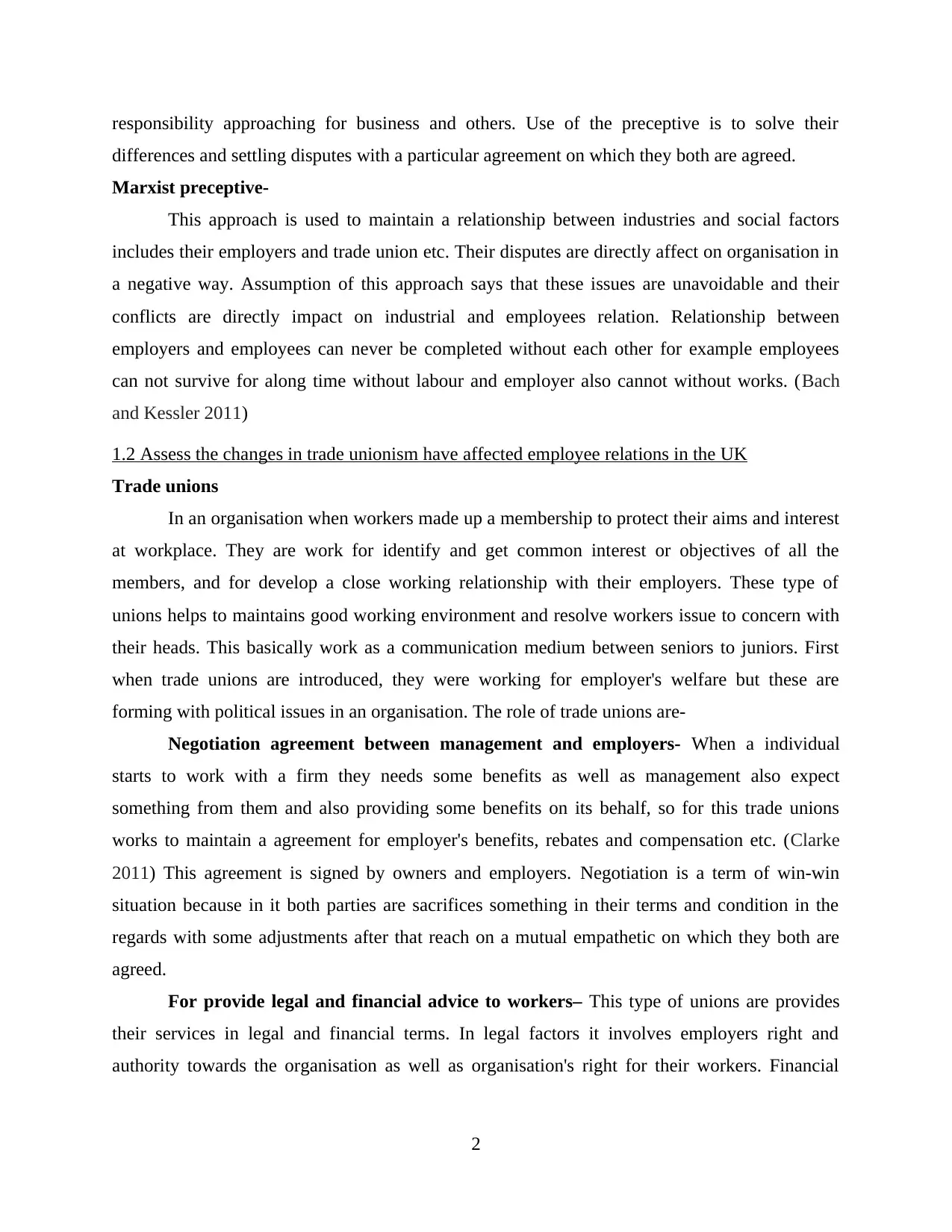
responsibility approaching for business and others. Use of the preceptive is to solve their
differences and settling disputes with a particular agreement on which they both are agreed.
Marxist preceptive-
This approach is used to maintain a relationship between industries and social factors
includes their employers and trade union etc. Their disputes are directly affect on organisation in
a negative way. Assumption of this approach says that these issues are unavoidable and their
conflicts are directly impact on industrial and employees relation. Relationship between
employers and employees can never be completed without each other for example employees
can not survive for along time without labour and employer also cannot without works. (Bach
and Kessler 2011)
1.2 Assess the changes in trade unionism have affected employee relations in the UK
Trade unions
In an organisation when workers made up a membership to protect their aims and interest
at workplace. They are work for identify and get common interest or objectives of all the
members, and for develop a close working relationship with their employers. These type of
unions helps to maintains good working environment and resolve workers issue to concern with
their heads. This basically work as a communication medium between seniors to juniors. First
when trade unions are introduced, they were working for employer's welfare but these are
forming with political issues in an organisation. The role of trade unions are-
Negotiation agreement between management and employers- When a individual
starts to work with a firm they needs some benefits as well as management also expect
something from them and also providing some benefits on its behalf, so for this trade unions
works to maintain a agreement for employer's benefits, rebates and compensation etc. (Clarke
2011) This agreement is signed by owners and employers. Negotiation is a term of win-win
situation because in it both parties are sacrifices something in their terms and condition in the
regards with some adjustments after that reach on a mutual empathetic on which they both are
agreed.
For provide legal and financial advice to workers– This type of unions are provides
their services in legal and financial terms. In legal factors it involves employers right and
authority towards the organisation as well as organisation's right for their workers. Financial
2
differences and settling disputes with a particular agreement on which they both are agreed.
Marxist preceptive-
This approach is used to maintain a relationship between industries and social factors
includes their employers and trade union etc. Their disputes are directly affect on organisation in
a negative way. Assumption of this approach says that these issues are unavoidable and their
conflicts are directly impact on industrial and employees relation. Relationship between
employers and employees can never be completed without each other for example employees
can not survive for along time without labour and employer also cannot without works. (Bach
and Kessler 2011)
1.2 Assess the changes in trade unionism have affected employee relations in the UK
Trade unions
In an organisation when workers made up a membership to protect their aims and interest
at workplace. They are work for identify and get common interest or objectives of all the
members, and for develop a close working relationship with their employers. These type of
unions helps to maintains good working environment and resolve workers issue to concern with
their heads. This basically work as a communication medium between seniors to juniors. First
when trade unions are introduced, they were working for employer's welfare but these are
forming with political issues in an organisation. The role of trade unions are-
Negotiation agreement between management and employers- When a individual
starts to work with a firm they needs some benefits as well as management also expect
something from them and also providing some benefits on its behalf, so for this trade unions
works to maintain a agreement for employer's benefits, rebates and compensation etc. (Clarke
2011) This agreement is signed by owners and employers. Negotiation is a term of win-win
situation because in it both parties are sacrifices something in their terms and condition in the
regards with some adjustments after that reach on a mutual empathetic on which they both are
agreed.
For provide legal and financial advice to workers– This type of unions are provides
their services in legal and financial terms. In legal factors it involves employers right and
authority towards the organisation as well as organisation's right for their workers. Financial
2
Secure Best Marks with AI Grader
Need help grading? Try our AI Grader for instant feedback on your assignments.
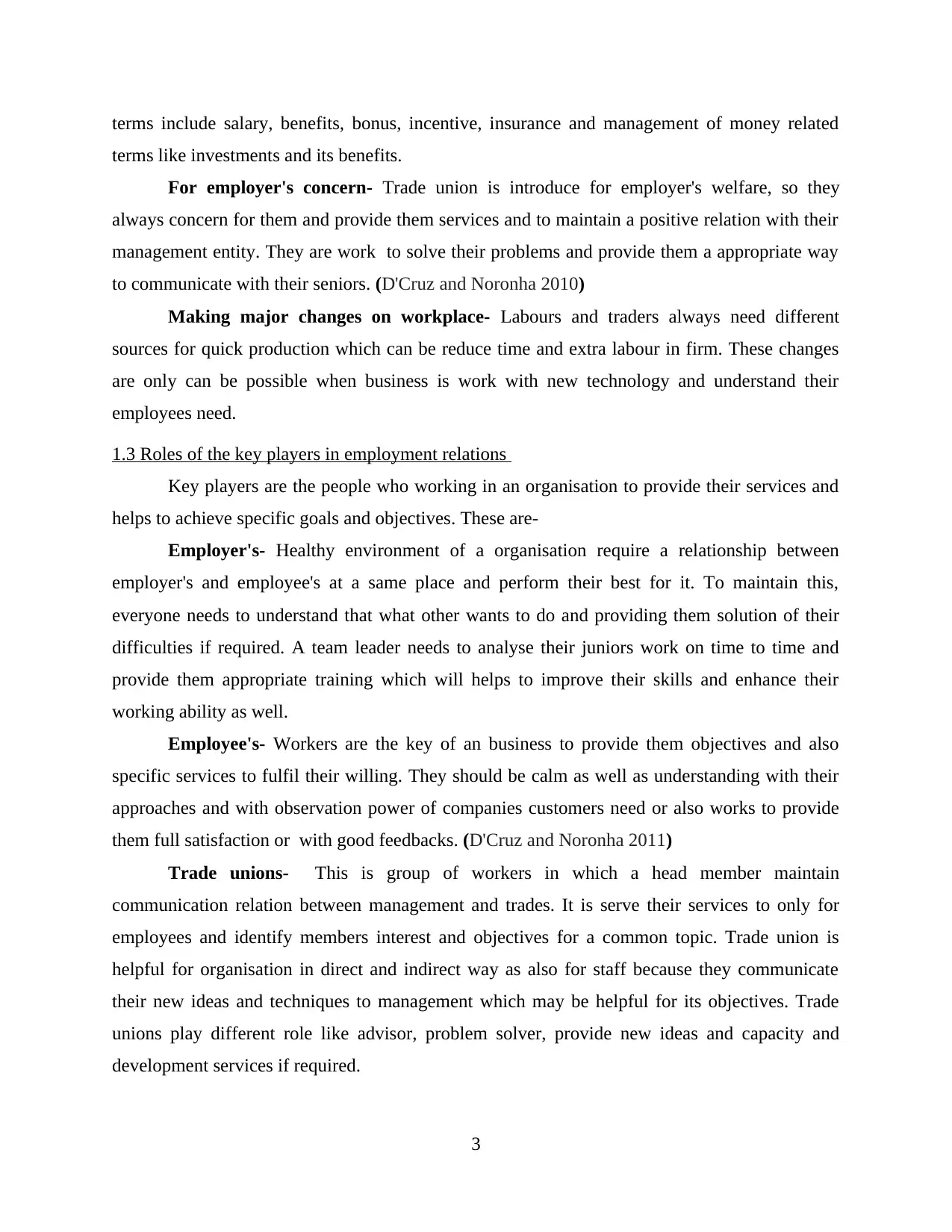
terms include salary, benefits, bonus, incentive, insurance and management of money related
terms like investments and its benefits.
For employer's concern- Trade union is introduce for employer's welfare, so they
always concern for them and provide them services and to maintain a positive relation with their
management entity. They are work to solve their problems and provide them a appropriate way
to communicate with their seniors. (D'Cruz and Noronha 2010)
Making major changes on workplace- Labours and traders always need different
sources for quick production which can be reduce time and extra labour in firm. These changes
are only can be possible when business is work with new technology and understand their
employees need.
1.3 Roles of the key players in employment relations
Key players are the people who working in an organisation to provide their services and
helps to achieve specific goals and objectives. These are-
Employer's- Healthy environment of a organisation require a relationship between
employer's and employee's at a same place and perform their best for it. To maintain this,
everyone needs to understand that what other wants to do and providing them solution of their
difficulties if required. A team leader needs to analyse their juniors work on time to time and
provide them appropriate training which will helps to improve their skills and enhance their
working ability as well.
Employee's- Workers are the key of an business to provide them objectives and also
specific services to fulfil their willing. They should be calm as well as understanding with their
approaches and with observation power of companies customers need or also works to provide
them full satisfaction or with good feedbacks. (D'Cruz and Noronha 2011)
Trade unions- This is group of workers in which a head member maintain
communication relation between management and trades. It is serve their services to only for
employees and identify members interest and objectives for a common topic. Trade union is
helpful for organisation in direct and indirect way as also for staff because they communicate
their new ideas and techniques to management which may be helpful for its objectives. Trade
unions play different role like advisor, problem solver, provide new ideas and capacity and
development services if required.
3
terms like investments and its benefits.
For employer's concern- Trade union is introduce for employer's welfare, so they
always concern for them and provide them services and to maintain a positive relation with their
management entity. They are work to solve their problems and provide them a appropriate way
to communicate with their seniors. (D'Cruz and Noronha 2010)
Making major changes on workplace- Labours and traders always need different
sources for quick production which can be reduce time and extra labour in firm. These changes
are only can be possible when business is work with new technology and understand their
employees need.
1.3 Roles of the key players in employment relations
Key players are the people who working in an organisation to provide their services and
helps to achieve specific goals and objectives. These are-
Employer's- Healthy environment of a organisation require a relationship between
employer's and employee's at a same place and perform their best for it. To maintain this,
everyone needs to understand that what other wants to do and providing them solution of their
difficulties if required. A team leader needs to analyse their juniors work on time to time and
provide them appropriate training which will helps to improve their skills and enhance their
working ability as well.
Employee's- Workers are the key of an business to provide them objectives and also
specific services to fulfil their willing. They should be calm as well as understanding with their
approaches and with observation power of companies customers need or also works to provide
them full satisfaction or with good feedbacks. (D'Cruz and Noronha 2011)
Trade unions- This is group of workers in which a head member maintain
communication relation between management and trades. It is serve their services to only for
employees and identify members interest and objectives for a common topic. Trade union is
helpful for organisation in direct and indirect way as also for staff because they communicate
their new ideas and techniques to management which may be helpful for its objectives. Trade
unions play different role like advisor, problem solver, provide new ideas and capacity and
development services if required.
3
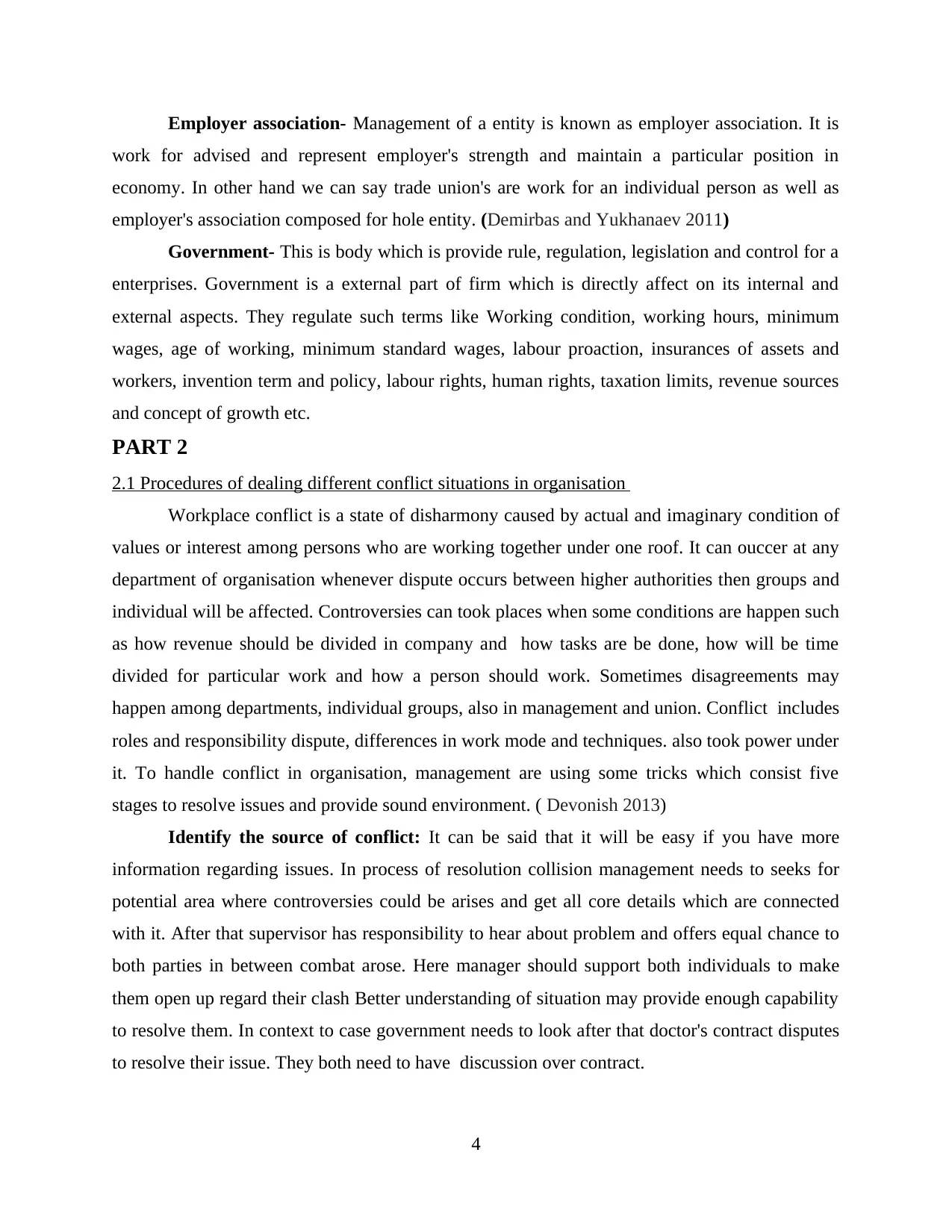
Employer association- Management of a entity is known as employer association. It is
work for advised and represent employer's strength and maintain a particular position in
economy. In other hand we can say trade union's are work for an individual person as well as
employer's association composed for hole entity. (Demirbas and Yukhanaev 2011)
Government- This is body which is provide rule, regulation, legislation and control for a
enterprises. Government is a external part of firm which is directly affect on its internal and
external aspects. They regulate such terms like Working condition, working hours, minimum
wages, age of working, minimum standard wages, labour proaction, insurances of assets and
workers, invention term and policy, labour rights, human rights, taxation limits, revenue sources
and concept of growth etc.
PART 2
2.1 Procedures of dealing different conflict situations in organisation
Workplace conflict is a state of disharmony caused by actual and imaginary condition of
values or interest among persons who are working together under one roof. It can ouccer at any
department of organisation whenever dispute occurs between higher authorities then groups and
individual will be affected. Controversies can took places when some conditions are happen such
as how revenue should be divided in company and how tasks are be done, how will be time
divided for particular work and how a person should work. Sometimes disagreements may
happen among departments, individual groups, also in management and union. Conflict includes
roles and responsibility dispute, differences in work mode and techniques. also took power under
it. To handle conflict in organisation, management are using some tricks which consist five
stages to resolve issues and provide sound environment. ( Devonish 2013)
Identify the source of conflict: It can be said that it will be easy if you have more
information regarding issues. In process of resolution collision management needs to seeks for
potential area where controversies could be arises and get all core details which are connected
with it. After that supervisor has responsibility to hear about problem and offers equal chance to
both parties in between combat arose. Here manager should support both individuals to make
them open up regard their clash Better understanding of situation may provide enough capability
to resolve them. In context to case government needs to look after that doctor's contract disputes
to resolve their issue. They both need to have discussion over contract.
4
work for advised and represent employer's strength and maintain a particular position in
economy. In other hand we can say trade union's are work for an individual person as well as
employer's association composed for hole entity. (Demirbas and Yukhanaev 2011)
Government- This is body which is provide rule, regulation, legislation and control for a
enterprises. Government is a external part of firm which is directly affect on its internal and
external aspects. They regulate such terms like Working condition, working hours, minimum
wages, age of working, minimum standard wages, labour proaction, insurances of assets and
workers, invention term and policy, labour rights, human rights, taxation limits, revenue sources
and concept of growth etc.
PART 2
2.1 Procedures of dealing different conflict situations in organisation
Workplace conflict is a state of disharmony caused by actual and imaginary condition of
values or interest among persons who are working together under one roof. It can ouccer at any
department of organisation whenever dispute occurs between higher authorities then groups and
individual will be affected. Controversies can took places when some conditions are happen such
as how revenue should be divided in company and how tasks are be done, how will be time
divided for particular work and how a person should work. Sometimes disagreements may
happen among departments, individual groups, also in management and union. Conflict includes
roles and responsibility dispute, differences in work mode and techniques. also took power under
it. To handle conflict in organisation, management are using some tricks which consist five
stages to resolve issues and provide sound environment. ( Devonish 2013)
Identify the source of conflict: It can be said that it will be easy if you have more
information regarding issues. In process of resolution collision management needs to seeks for
potential area where controversies could be arises and get all core details which are connected
with it. After that supervisor has responsibility to hear about problem and offers equal chance to
both parties in between combat arose. Here manager should support both individuals to make
them open up regard their clash Better understanding of situation may provide enough capability
to resolve them. In context to case government needs to look after that doctor's contract disputes
to resolve their issue. They both need to have discussion over contract.
4
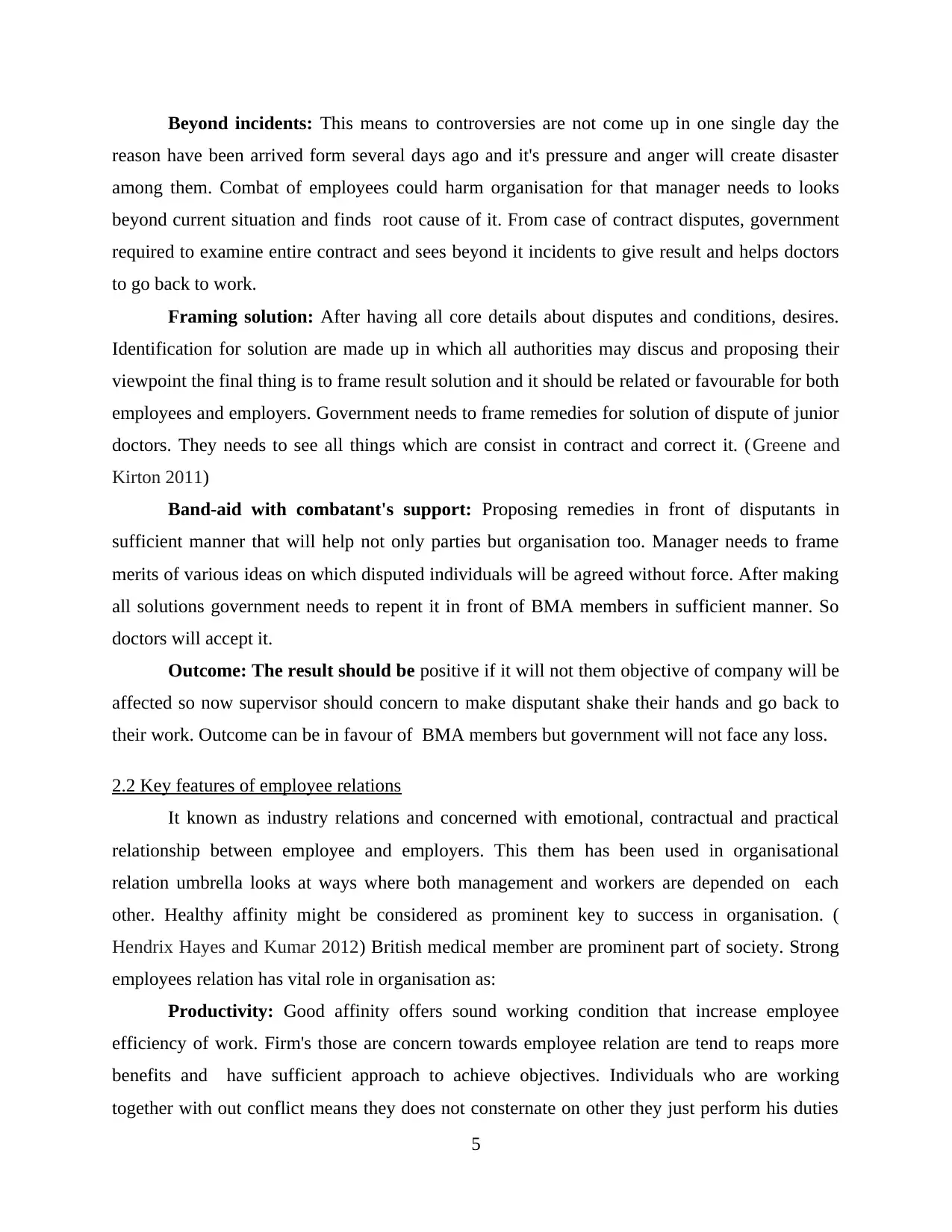
Beyond incidents: This means to controversies are not come up in one single day the
reason have been arrived form several days ago and it's pressure and anger will create disaster
among them. Combat of employees could harm organisation for that manager needs to looks
beyond current situation and finds root cause of it. From case of contract disputes, government
required to examine entire contract and sees beyond it incidents to give result and helps doctors
to go back to work.
Framing solution: After having all core details about disputes and conditions, desires.
Identification for solution are made up in which all authorities may discus and proposing their
viewpoint the final thing is to frame result solution and it should be related or favourable for both
employees and employers. Government needs to frame remedies for solution of dispute of junior
doctors. They needs to see all things which are consist in contract and correct it. (Greene and
Kirton 2011)
Band-aid with combatant's support: Proposing remedies in front of disputants in
sufficient manner that will help not only parties but organisation too. Manager needs to frame
merits of various ideas on which disputed individuals will be agreed without force. After making
all solutions government needs to repent it in front of BMA members in sufficient manner. So
doctors will accept it.
Outcome: The result should be positive if it will not them objective of company will be
affected so now supervisor should concern to make disputant shake their hands and go back to
their work. Outcome can be in favour of BMA members but government will not face any loss.
2.2 Key features of employee relations
It known as industry relations and concerned with emotional, contractual and practical
relationship between employee and employers. This them has been used in organisational
relation umbrella looks at ways where both management and workers are depended on each
other. Healthy affinity might be considered as prominent key to success in organisation. (
Hendrix Hayes and Kumar 2012) British medical member are prominent part of society. Strong
employees relation has vital role in organisation as:
Productivity: Good affinity offers sound working condition that increase employee
efficiency of work. Firm's those are concern towards employee relation are tend to reaps more
benefits and have sufficient approach to achieve objectives. Individuals who are working
together with out conflict means they does not consternate on other they just perform his duties
5
reason have been arrived form several days ago and it's pressure and anger will create disaster
among them. Combat of employees could harm organisation for that manager needs to looks
beyond current situation and finds root cause of it. From case of contract disputes, government
required to examine entire contract and sees beyond it incidents to give result and helps doctors
to go back to work.
Framing solution: After having all core details about disputes and conditions, desires.
Identification for solution are made up in which all authorities may discus and proposing their
viewpoint the final thing is to frame result solution and it should be related or favourable for both
employees and employers. Government needs to frame remedies for solution of dispute of junior
doctors. They needs to see all things which are consist in contract and correct it. (Greene and
Kirton 2011)
Band-aid with combatant's support: Proposing remedies in front of disputants in
sufficient manner that will help not only parties but organisation too. Manager needs to frame
merits of various ideas on which disputed individuals will be agreed without force. After making
all solutions government needs to repent it in front of BMA members in sufficient manner. So
doctors will accept it.
Outcome: The result should be positive if it will not them objective of company will be
affected so now supervisor should concern to make disputant shake their hands and go back to
their work. Outcome can be in favour of BMA members but government will not face any loss.
2.2 Key features of employee relations
It known as industry relations and concerned with emotional, contractual and practical
relationship between employee and employers. This them has been used in organisational
relation umbrella looks at ways where both management and workers are depended on each
other. Healthy affinity might be considered as prominent key to success in organisation. (
Hendrix Hayes and Kumar 2012) British medical member are prominent part of society. Strong
employees relation has vital role in organisation as:
Productivity: Good affinity offers sound working condition that increase employee
efficiency of work. Firm's those are concern towards employee relation are tend to reaps more
benefits and have sufficient approach to achieve objectives. Individuals who are working
together with out conflict means they does not consternate on other they just perform his duties
5
Paraphrase This Document
Need a fresh take? Get an instant paraphrase of this document with our AI Paraphraser
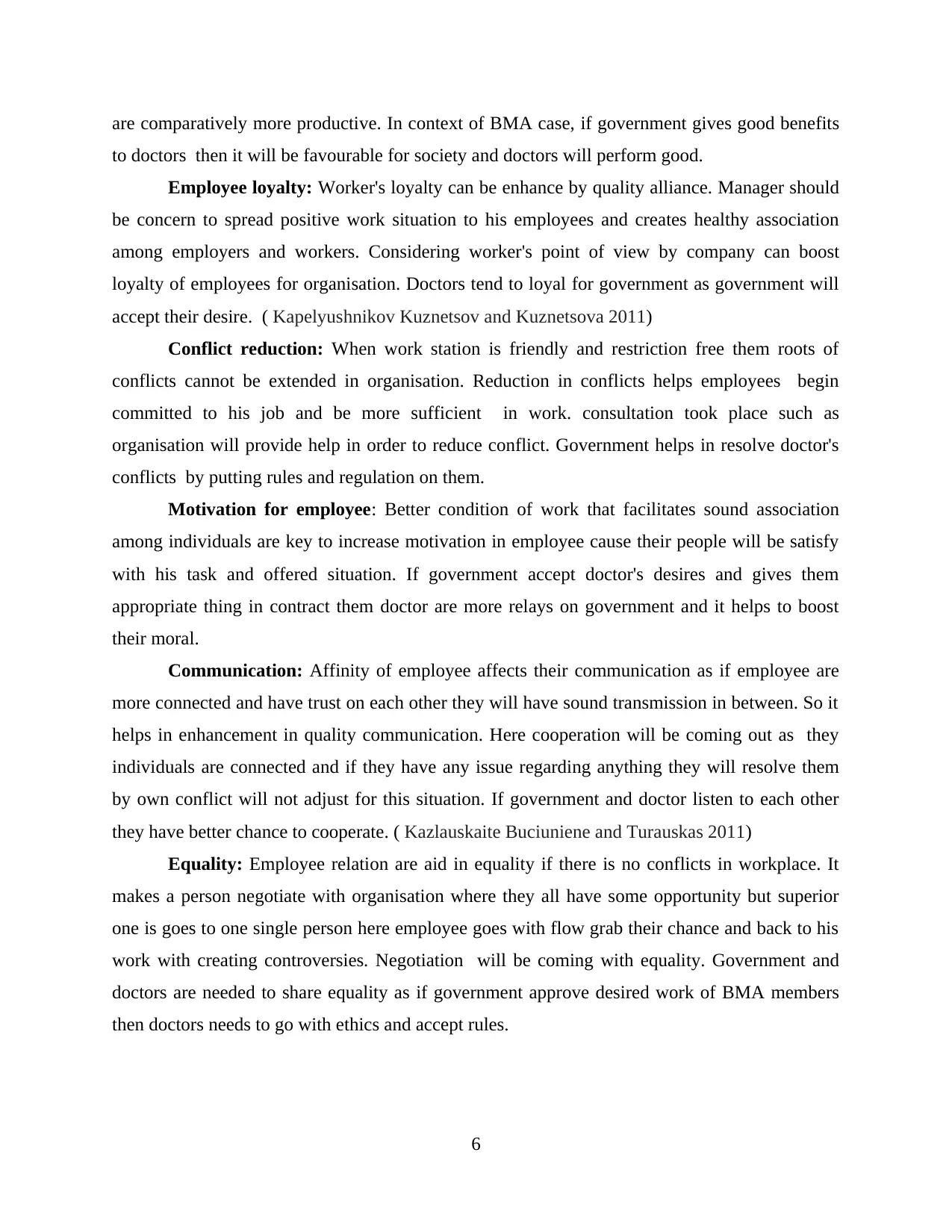
are comparatively more productive. In context of BMA case, if government gives good benefits
to doctors then it will be favourable for society and doctors will perform good.
Employee loyalty: Worker's loyalty can be enhance by quality alliance. Manager should
be concern to spread positive work situation to his employees and creates healthy association
among employers and workers. Considering worker's point of view by company can boost
loyalty of employees for organisation. Doctors tend to loyal for government as government will
accept their desire. ( Kapelyushnikov Kuznetsov and Kuznetsova 2011)
Conflict reduction: When work station is friendly and restriction free them roots of
conflicts cannot be extended in organisation. Reduction in conflicts helps employees begin
committed to his job and be more sufficient in work. consultation took place such as
organisation will provide help in order to reduce conflict. Government helps in resolve doctor's
conflicts by putting rules and regulation on them.
Motivation for employee: Better condition of work that facilitates sound association
among individuals are key to increase motivation in employee cause their people will be satisfy
with his task and offered situation. If government accept doctor's desires and gives them
appropriate thing in contract them doctor are more relays on government and it helps to boost
their moral.
Communication: Affinity of employee affects their communication as if employee are
more connected and have trust on each other they will have sound transmission in between. So it
helps in enhancement in quality communication. Here cooperation will be coming out as they
individuals are connected and if they have any issue regarding anything they will resolve them
by own conflict will not adjust for this situation. If government and doctor listen to each other
they have better chance to cooperate. ( Kazlauskaite Buciuniene and Turauskas 2011)
Equality: Employee relation are aid in equality if there is no conflicts in workplace. It
makes a person negotiate with organisation where they all have some opportunity but superior
one is goes to one single person here employee goes with flow grab their chance and back to his
work with creating controversies. Negotiation will be coming with equality. Government and
doctors are needed to share equality as if government approve desired work of BMA members
then doctors needs to go with ethics and accept rules.
6
to doctors then it will be favourable for society and doctors will perform good.
Employee loyalty: Worker's loyalty can be enhance by quality alliance. Manager should
be concern to spread positive work situation to his employees and creates healthy association
among employers and workers. Considering worker's point of view by company can boost
loyalty of employees for organisation. Doctors tend to loyal for government as government will
accept their desire. ( Kapelyushnikov Kuznetsov and Kuznetsova 2011)
Conflict reduction: When work station is friendly and restriction free them roots of
conflicts cannot be extended in organisation. Reduction in conflicts helps employees begin
committed to his job and be more sufficient in work. consultation took place such as
organisation will provide help in order to reduce conflict. Government helps in resolve doctor's
conflicts by putting rules and regulation on them.
Motivation for employee: Better condition of work that facilitates sound association
among individuals are key to increase motivation in employee cause their people will be satisfy
with his task and offered situation. If government accept doctor's desires and gives them
appropriate thing in contract them doctor are more relays on government and it helps to boost
their moral.
Communication: Affinity of employee affects their communication as if employee are
more connected and have trust on each other they will have sound transmission in between. So it
helps in enhancement in quality communication. Here cooperation will be coming out as they
individuals are connected and if they have any issue regarding anything they will resolve them
by own conflict will not adjust for this situation. If government and doctor listen to each other
they have better chance to cooperate. ( Kazlauskaite Buciuniene and Turauskas 2011)
Equality: Employee relation are aid in equality if there is no conflicts in workplace. It
makes a person negotiate with organisation where they all have some opportunity but superior
one is goes to one single person here employee goes with flow grab their chance and back to his
work with creating controversies. Negotiation will be coming with equality. Government and
doctors are needed to share equality as if government approve desired work of BMA members
then doctors needs to go with ethics and accept rules.
6
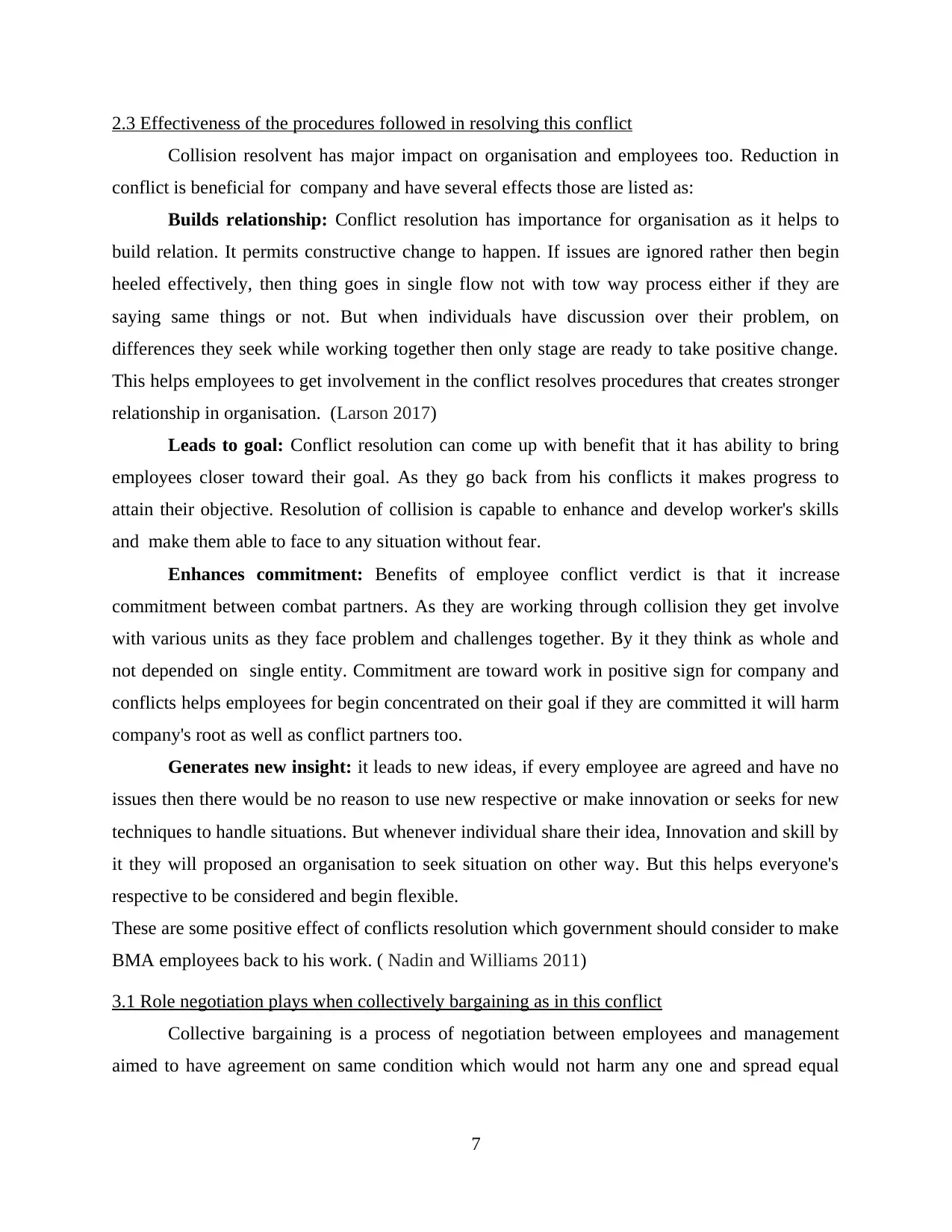
2.3 Effectiveness of the procedures followed in resolving this conflict
Collision resolvent has major impact on organisation and employees too. Reduction in
conflict is beneficial for company and have several effects those are listed as:
Builds relationship: Conflict resolution has importance for organisation as it helps to
build relation. It permits constructive change to happen. If issues are ignored rather then begin
heeled effectively, then thing goes in single flow not with tow way process either if they are
saying same things or not. But when individuals have discussion over their problem, on
differences they seek while working together then only stage are ready to take positive change.
This helps employees to get involvement in the conflict resolves procedures that creates stronger
relationship in organisation. (Larson 2017)
Leads to goal: Conflict resolution can come up with benefit that it has ability to bring
employees closer toward their goal. As they go back from his conflicts it makes progress to
attain their objective. Resolution of collision is capable to enhance and develop worker's skills
and make them able to face to any situation without fear.
Enhances commitment: Benefits of employee conflict verdict is that it increase
commitment between combat partners. As they are working through collision they get involve
with various units as they face problem and challenges together. By it they think as whole and
not depended on single entity. Commitment are toward work in positive sign for company and
conflicts helps employees for begin concentrated on their goal if they are committed it will harm
company's root as well as conflict partners too.
Generates new insight: it leads to new ideas, if every employee are agreed and have no
issues then there would be no reason to use new respective or make innovation or seeks for new
techniques to handle situations. But whenever individual share their idea, Innovation and skill by
it they will proposed an organisation to seek situation on other way. But this helps everyone's
respective to be considered and begin flexible.
These are some positive effect of conflicts resolution which government should consider to make
BMA employees back to his work. ( Nadin and Williams 2011)
3.1 Role negotiation plays when collectively bargaining as in this conflict
Collective bargaining is a process of negotiation between employees and management
aimed to have agreement on same condition which would not harm any one and spread equal
7
Collision resolvent has major impact on organisation and employees too. Reduction in
conflict is beneficial for company and have several effects those are listed as:
Builds relationship: Conflict resolution has importance for organisation as it helps to
build relation. It permits constructive change to happen. If issues are ignored rather then begin
heeled effectively, then thing goes in single flow not with tow way process either if they are
saying same things or not. But when individuals have discussion over their problem, on
differences they seek while working together then only stage are ready to take positive change.
This helps employees to get involvement in the conflict resolves procedures that creates stronger
relationship in organisation. (Larson 2017)
Leads to goal: Conflict resolution can come up with benefit that it has ability to bring
employees closer toward their goal. As they go back from his conflicts it makes progress to
attain their objective. Resolution of collision is capable to enhance and develop worker's skills
and make them able to face to any situation without fear.
Enhances commitment: Benefits of employee conflict verdict is that it increase
commitment between combat partners. As they are working through collision they get involve
with various units as they face problem and challenges together. By it they think as whole and
not depended on single entity. Commitment are toward work in positive sign for company and
conflicts helps employees for begin concentrated on their goal if they are committed it will harm
company's root as well as conflict partners too.
Generates new insight: it leads to new ideas, if every employee are agreed and have no
issues then there would be no reason to use new respective or make innovation or seeks for new
techniques to handle situations. But whenever individual share their idea, Innovation and skill by
it they will proposed an organisation to seek situation on other way. But this helps everyone's
respective to be considered and begin flexible.
These are some positive effect of conflicts resolution which government should consider to make
BMA employees back to his work. ( Nadin and Williams 2011)
3.1 Role negotiation plays when collectively bargaining as in this conflict
Collective bargaining is a process of negotiation between employees and management
aimed to have agreement on same condition which would not harm any one and spread equal
7
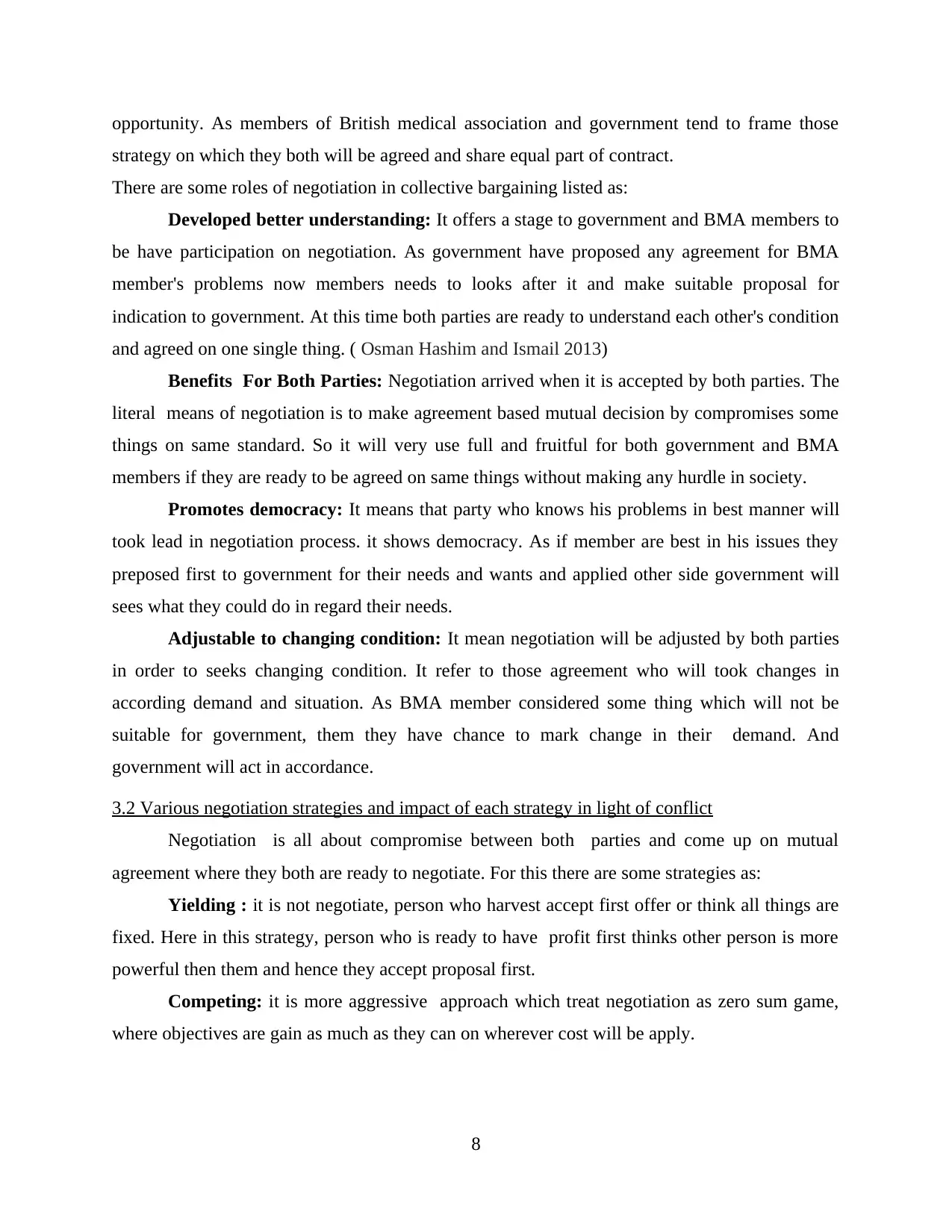
opportunity. As members of British medical association and government tend to frame those
strategy on which they both will be agreed and share equal part of contract.
There are some roles of negotiation in collective bargaining listed as:
Developed better understanding: It offers a stage to government and BMA members to
be have participation on negotiation. As government have proposed any agreement for BMA
member's problems now members needs to looks after it and make suitable proposal for
indication to government. At this time both parties are ready to understand each other's condition
and agreed on one single thing. ( Osman Hashim and Ismail 2013)
Benefits For Both Parties: Negotiation arrived when it is accepted by both parties. The
literal means of negotiation is to make agreement based mutual decision by compromises some
things on same standard. So it will very use full and fruitful for both government and BMA
members if they are ready to be agreed on same things without making any hurdle in society.
Promotes democracy: It means that party who knows his problems in best manner will
took lead in negotiation process. it shows democracy. As if member are best in his issues they
preposed first to government for their needs and wants and applied other side government will
sees what they could do in regard their needs.
Adjustable to changing condition: It mean negotiation will be adjusted by both parties
in order to seeks changing condition. It refer to those agreement who will took changes in
according demand and situation. As BMA member considered some thing which will not be
suitable for government, them they have chance to mark change in their demand. And
government will act in accordance.
3.2 Various negotiation strategies and impact of each strategy in light of conflict
Negotiation is all about compromise between both parties and come up on mutual
agreement where they both are ready to negotiate. For this there are some strategies as:
Yielding : it is not negotiate, person who harvest accept first offer or think all things are
fixed. Here in this strategy, person who is ready to have profit first thinks other person is more
powerful then them and hence they accept proposal first.
Competing: it is more aggressive approach which treat negotiation as zero sum game,
where objectives are gain as much as they can on wherever cost will be apply.
8
strategy on which they both will be agreed and share equal part of contract.
There are some roles of negotiation in collective bargaining listed as:
Developed better understanding: It offers a stage to government and BMA members to
be have participation on negotiation. As government have proposed any agreement for BMA
member's problems now members needs to looks after it and make suitable proposal for
indication to government. At this time both parties are ready to understand each other's condition
and agreed on one single thing. ( Osman Hashim and Ismail 2013)
Benefits For Both Parties: Negotiation arrived when it is accepted by both parties. The
literal means of negotiation is to make agreement based mutual decision by compromises some
things on same standard. So it will very use full and fruitful for both government and BMA
members if they are ready to be agreed on same things without making any hurdle in society.
Promotes democracy: It means that party who knows his problems in best manner will
took lead in negotiation process. it shows democracy. As if member are best in his issues they
preposed first to government for their needs and wants and applied other side government will
sees what they could do in regard their needs.
Adjustable to changing condition: It mean negotiation will be adjusted by both parties
in order to seeks changing condition. It refer to those agreement who will took changes in
according demand and situation. As BMA member considered some thing which will not be
suitable for government, them they have chance to mark change in their demand. And
government will act in accordance.
3.2 Various negotiation strategies and impact of each strategy in light of conflict
Negotiation is all about compromise between both parties and come up on mutual
agreement where they both are ready to negotiate. For this there are some strategies as:
Yielding : it is not negotiate, person who harvest accept first offer or think all things are
fixed. Here in this strategy, person who is ready to have profit first thinks other person is more
powerful then them and hence they accept proposal first.
Competing: it is more aggressive approach which treat negotiation as zero sum game,
where objectives are gain as much as they can on wherever cost will be apply.
8
Secure Best Marks with AI Grader
Need help grading? Try our AI Grader for instant feedback on your assignments.
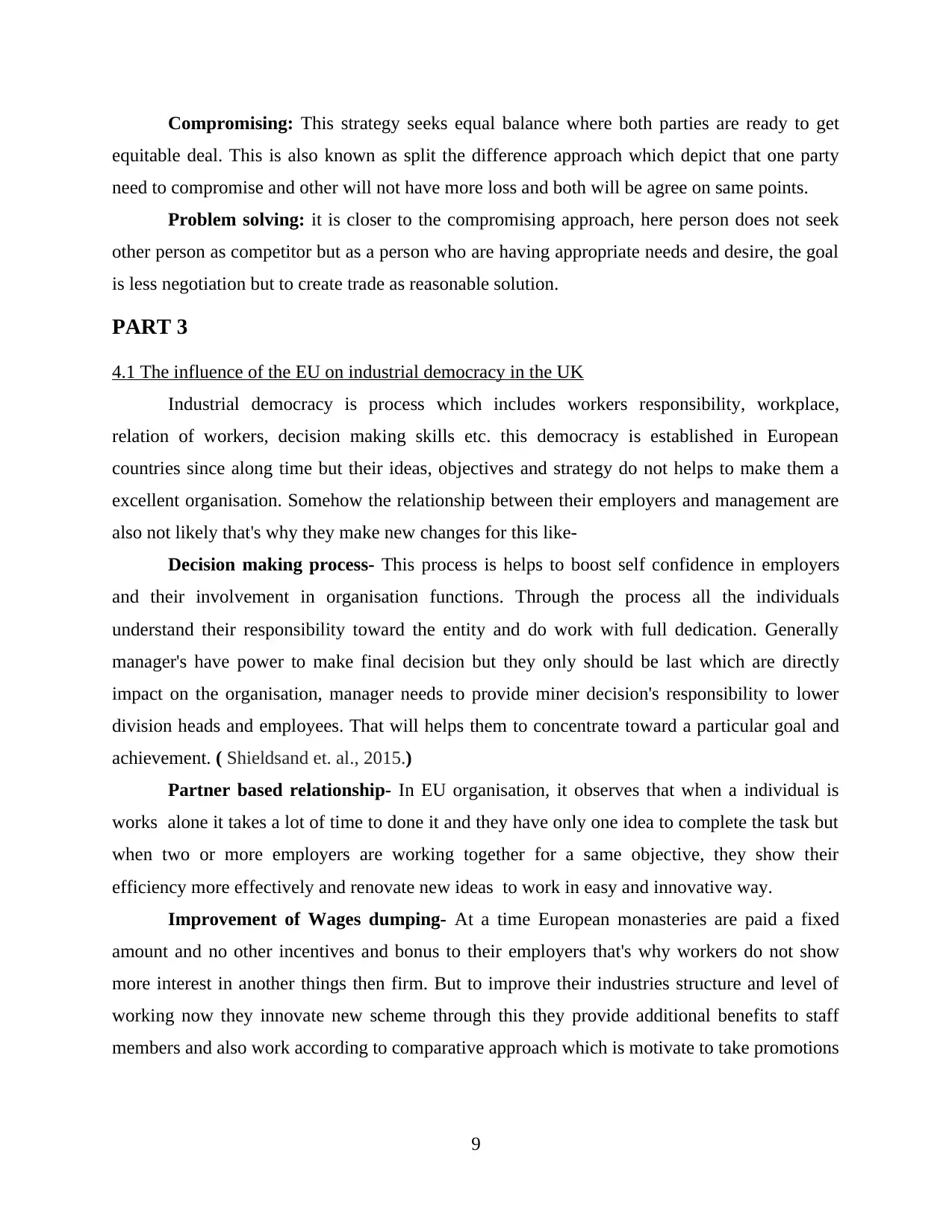
Compromising: This strategy seeks equal balance where both parties are ready to get
equitable deal. This is also known as split the difference approach which depict that one party
need to compromise and other will not have more loss and both will be agree on same points.
Problem solving: it is closer to the compromising approach, here person does not seek
other person as competitor but as a person who are having appropriate needs and desire, the goal
is less negotiation but to create trade as reasonable solution.
PART 3
4.1 The influence of the EU on industrial democracy in the UK
Industrial democracy is process which includes workers responsibility, workplace,
relation of workers, decision making skills etc. this democracy is established in European
countries since along time but their ideas, objectives and strategy do not helps to make them a
excellent organisation. Somehow the relationship between their employers and management are
also not likely that's why they make new changes for this like-
Decision making process- This process is helps to boost self confidence in employers
and their involvement in organisation functions. Through the process all the individuals
understand their responsibility toward the entity and do work with full dedication. Generally
manager's have power to make final decision but they only should be last which are directly
impact on the organisation, manager needs to provide miner decision's responsibility to lower
division heads and employees. That will helps them to concentrate toward a particular goal and
achievement. ( Shieldsand et. al., 2015.)
Partner based relationship- In EU organisation, it observes that when a individual is
works alone it takes a lot of time to done it and they have only one idea to complete the task but
when two or more employers are working together for a same objective, they show their
efficiency more effectively and renovate new ideas to work in easy and innovative way.
Improvement of Wages dumping- At a time European monasteries are paid a fixed
amount and no other incentives and bonus to their employers that's why workers do not show
more interest in another things then firm. But to improve their industries structure and level of
working now they innovate new scheme through this they provide additional benefits to staff
members and also work according to comparative approach which is motivate to take promotions
9
equitable deal. This is also known as split the difference approach which depict that one party
need to compromise and other will not have more loss and both will be agree on same points.
Problem solving: it is closer to the compromising approach, here person does not seek
other person as competitor but as a person who are having appropriate needs and desire, the goal
is less negotiation but to create trade as reasonable solution.
PART 3
4.1 The influence of the EU on industrial democracy in the UK
Industrial democracy is process which includes workers responsibility, workplace,
relation of workers, decision making skills etc. this democracy is established in European
countries since along time but their ideas, objectives and strategy do not helps to make them a
excellent organisation. Somehow the relationship between their employers and management are
also not likely that's why they make new changes for this like-
Decision making process- This process is helps to boost self confidence in employers
and their involvement in organisation functions. Through the process all the individuals
understand their responsibility toward the entity and do work with full dedication. Generally
manager's have power to make final decision but they only should be last which are directly
impact on the organisation, manager needs to provide miner decision's responsibility to lower
division heads and employees. That will helps them to concentrate toward a particular goal and
achievement. ( Shieldsand et. al., 2015.)
Partner based relationship- In EU organisation, it observes that when a individual is
works alone it takes a lot of time to done it and they have only one idea to complete the task but
when two or more employers are working together for a same objective, they show their
efficiency more effectively and renovate new ideas to work in easy and innovative way.
Improvement of Wages dumping- At a time European monasteries are paid a fixed
amount and no other incentives and bonus to their employers that's why workers do not show
more interest in another things then firm. But to improve their industries structure and level of
working now they innovate new scheme through this they provide additional benefits to staff
members and also work according to comparative approach which is motivate to take promotions
9
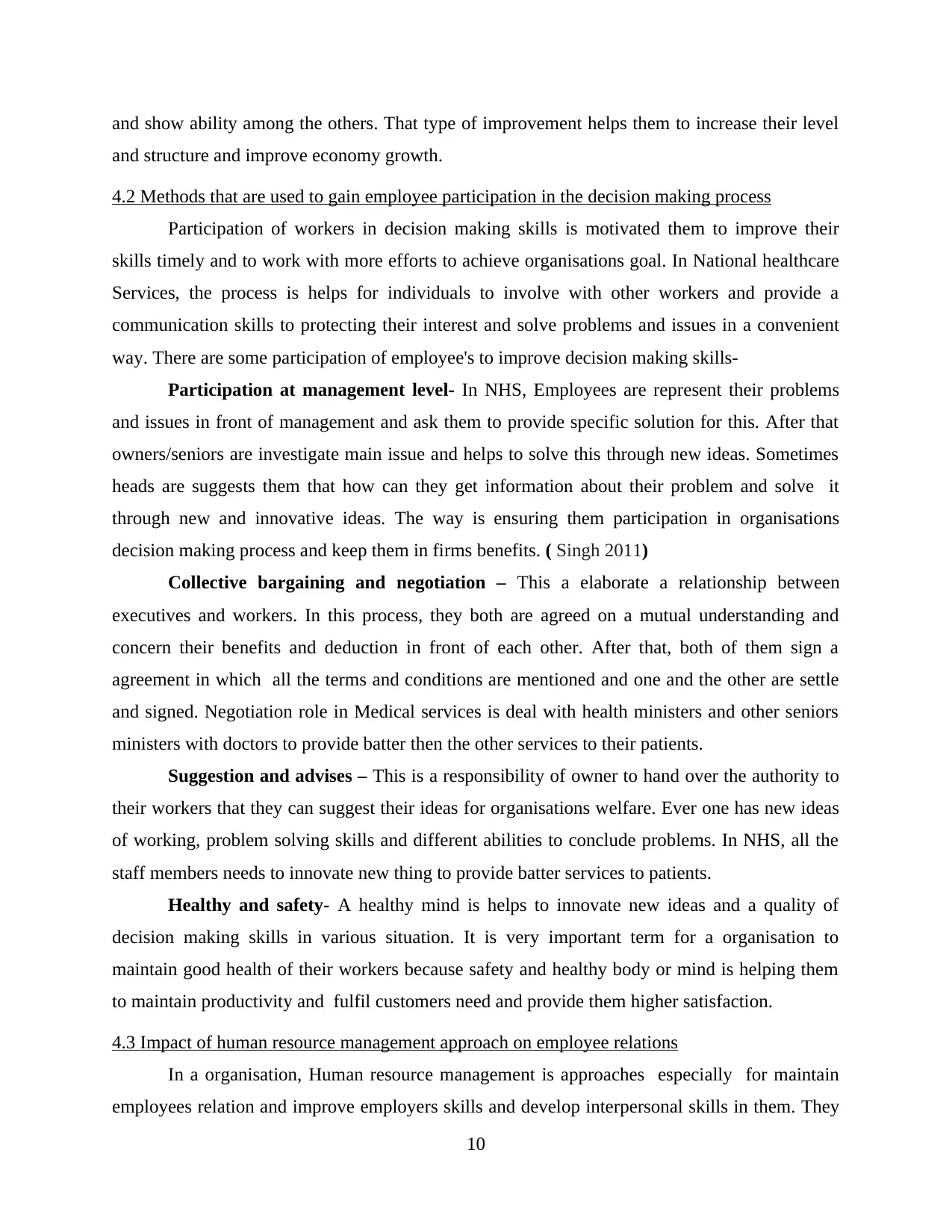
and show ability among the others. That type of improvement helps them to increase their level
and structure and improve economy growth.
4.2 Methods that are used to gain employee participation in the decision making process
Participation of workers in decision making skills is motivated them to improve their
skills timely and to work with more efforts to achieve organisations goal. In National healthcare
Services, the process is helps for individuals to involve with other workers and provide a
communication skills to protecting their interest and solve problems and issues in a convenient
way. There are some participation of employee's to improve decision making skills-
Participation at management level- In NHS, Employees are represent their problems
and issues in front of management and ask them to provide specific solution for this. After that
owners/seniors are investigate main issue and helps to solve this through new ideas. Sometimes
heads are suggests them that how can they get information about their problem and solve it
through new and innovative ideas. The way is ensuring them participation in organisations
decision making process and keep them in firms benefits. ( Singh 2011)
Collective bargaining and negotiation – This a elaborate a relationship between
executives and workers. In this process, they both are agreed on a mutual understanding and
concern their benefits and deduction in front of each other. After that, both of them sign a
agreement in which all the terms and conditions are mentioned and one and the other are settle
and signed. Negotiation role in Medical services is deal with health ministers and other seniors
ministers with doctors to provide batter then the other services to their patients.
Suggestion and advises – This is a responsibility of owner to hand over the authority to
their workers that they can suggest their ideas for organisations welfare. Ever one has new ideas
of working, problem solving skills and different abilities to conclude problems. In NHS, all the
staff members needs to innovate new thing to provide batter services to patients.
Healthy and safety- A healthy mind is helps to innovate new ideas and a quality of
decision making skills in various situation. It is very important term for a organisation to
maintain good health of their workers because safety and healthy body or mind is helping them
to maintain productivity and fulfil customers need and provide them higher satisfaction.
4.3 Impact of human resource management approach on employee relations
In a organisation, Human resource management is approaches especially for maintain
employees relation and improve employers skills and develop interpersonal skills in them. They
10
and structure and improve economy growth.
4.2 Methods that are used to gain employee participation in the decision making process
Participation of workers in decision making skills is motivated them to improve their
skills timely and to work with more efforts to achieve organisations goal. In National healthcare
Services, the process is helps for individuals to involve with other workers and provide a
communication skills to protecting their interest and solve problems and issues in a convenient
way. There are some participation of employee's to improve decision making skills-
Participation at management level- In NHS, Employees are represent their problems
and issues in front of management and ask them to provide specific solution for this. After that
owners/seniors are investigate main issue and helps to solve this through new ideas. Sometimes
heads are suggests them that how can they get information about their problem and solve it
through new and innovative ideas. The way is ensuring them participation in organisations
decision making process and keep them in firms benefits. ( Singh 2011)
Collective bargaining and negotiation – This a elaborate a relationship between
executives and workers. In this process, they both are agreed on a mutual understanding and
concern their benefits and deduction in front of each other. After that, both of them sign a
agreement in which all the terms and conditions are mentioned and one and the other are settle
and signed. Negotiation role in Medical services is deal with health ministers and other seniors
ministers with doctors to provide batter then the other services to their patients.
Suggestion and advises – This is a responsibility of owner to hand over the authority to
their workers that they can suggest their ideas for organisations welfare. Ever one has new ideas
of working, problem solving skills and different abilities to conclude problems. In NHS, all the
staff members needs to innovate new thing to provide batter services to patients.
Healthy and safety- A healthy mind is helps to innovate new ideas and a quality of
decision making skills in various situation. It is very important term for a organisation to
maintain good health of their workers because safety and healthy body or mind is helping them
to maintain productivity and fulfil customers need and provide them higher satisfaction.
4.3 Impact of human resource management approach on employee relations
In a organisation, Human resource management is approaches especially for maintain
employees relation and improve employers skills and develop interpersonal skills in them. They
10
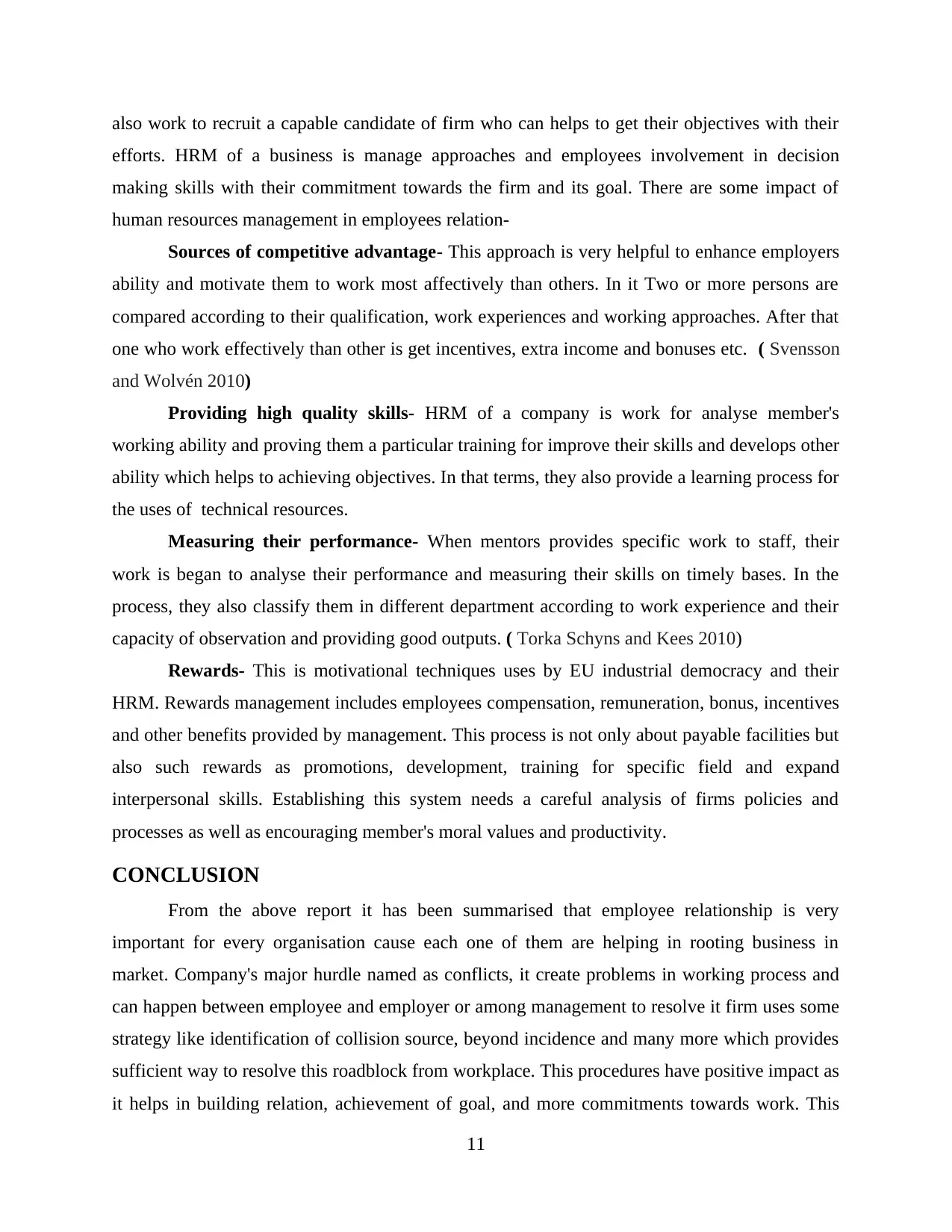
also work to recruit a capable candidate of firm who can helps to get their objectives with their
efforts. HRM of a business is manage approaches and employees involvement in decision
making skills with their commitment towards the firm and its goal. There are some impact of
human resources management in employees relation-
Sources of competitive advantage- This approach is very helpful to enhance employers
ability and motivate them to work most affectively than others. In it Two or more persons are
compared according to their qualification, work experiences and working approaches. After that
one who work effectively than other is get incentives, extra income and bonuses etc. ( Svensson
and Wolvén 2010)
Providing high quality skills- HRM of a company is work for analyse member's
working ability and proving them a particular training for improve their skills and develops other
ability which helps to achieving objectives. In that terms, they also provide a learning process for
the uses of technical resources.
Measuring their performance- When mentors provides specific work to staff, their
work is began to analyse their performance and measuring their skills on timely bases. In the
process, they also classify them in different department according to work experience and their
capacity of observation and providing good outputs. ( Torka Schyns and Kees 2010)
Rewards- This is motivational techniques uses by EU industrial democracy and their
HRM. Rewards management includes employees compensation, remuneration, bonus, incentives
and other benefits provided by management. This process is not only about payable facilities but
also such rewards as promotions, development, training for specific field and expand
interpersonal skills. Establishing this system needs a careful analysis of firms policies and
processes as well as encouraging member's moral values and productivity.
CONCLUSION
From the above report it has been summarised that employee relationship is very
important for every organisation cause each one of them are helping in rooting business in
market. Company's major hurdle named as conflicts, it create problems in working process and
can happen between employee and employer or among management to resolve it firm uses some
strategy like identification of collision source, beyond incidence and many more which provides
sufficient way to resolve this roadblock from workplace. This procedures have positive impact as
it helps in building relation, achievement of goal, and more commitments towards work. This
11
efforts. HRM of a business is manage approaches and employees involvement in decision
making skills with their commitment towards the firm and its goal. There are some impact of
human resources management in employees relation-
Sources of competitive advantage- This approach is very helpful to enhance employers
ability and motivate them to work most affectively than others. In it Two or more persons are
compared according to their qualification, work experiences and working approaches. After that
one who work effectively than other is get incentives, extra income and bonuses etc. ( Svensson
and Wolvén 2010)
Providing high quality skills- HRM of a company is work for analyse member's
working ability and proving them a particular training for improve their skills and develops other
ability which helps to achieving objectives. In that terms, they also provide a learning process for
the uses of technical resources.
Measuring their performance- When mentors provides specific work to staff, their
work is began to analyse their performance and measuring their skills on timely bases. In the
process, they also classify them in different department according to work experience and their
capacity of observation and providing good outputs. ( Torka Schyns and Kees 2010)
Rewards- This is motivational techniques uses by EU industrial democracy and their
HRM. Rewards management includes employees compensation, remuneration, bonus, incentives
and other benefits provided by management. This process is not only about payable facilities but
also such rewards as promotions, development, training for specific field and expand
interpersonal skills. Establishing this system needs a careful analysis of firms policies and
processes as well as encouraging member's moral values and productivity.
CONCLUSION
From the above report it has been summarised that employee relationship is very
important for every organisation cause each one of them are helping in rooting business in
market. Company's major hurdle named as conflicts, it create problems in working process and
can happen between employee and employer or among management to resolve it firm uses some
strategy like identification of collision source, beyond incidence and many more which provides
sufficient way to resolve this roadblock from workplace. This procedures have positive impact as
it helps in building relation, achievement of goal, and more commitments towards work. This
11
Paraphrase This Document
Need a fresh take? Get an instant paraphrase of this document with our AI Paraphraser

assignment also have negotiation roles and strategy which clarifies negotiation in collective
bargaining such as it give benefit to both parties, promotion of democracy and strategy as
yielding, competing and more.
12
bargaining such as it give benefit to both parties, promotion of democracy and strategy as
yielding, competing and more.
12
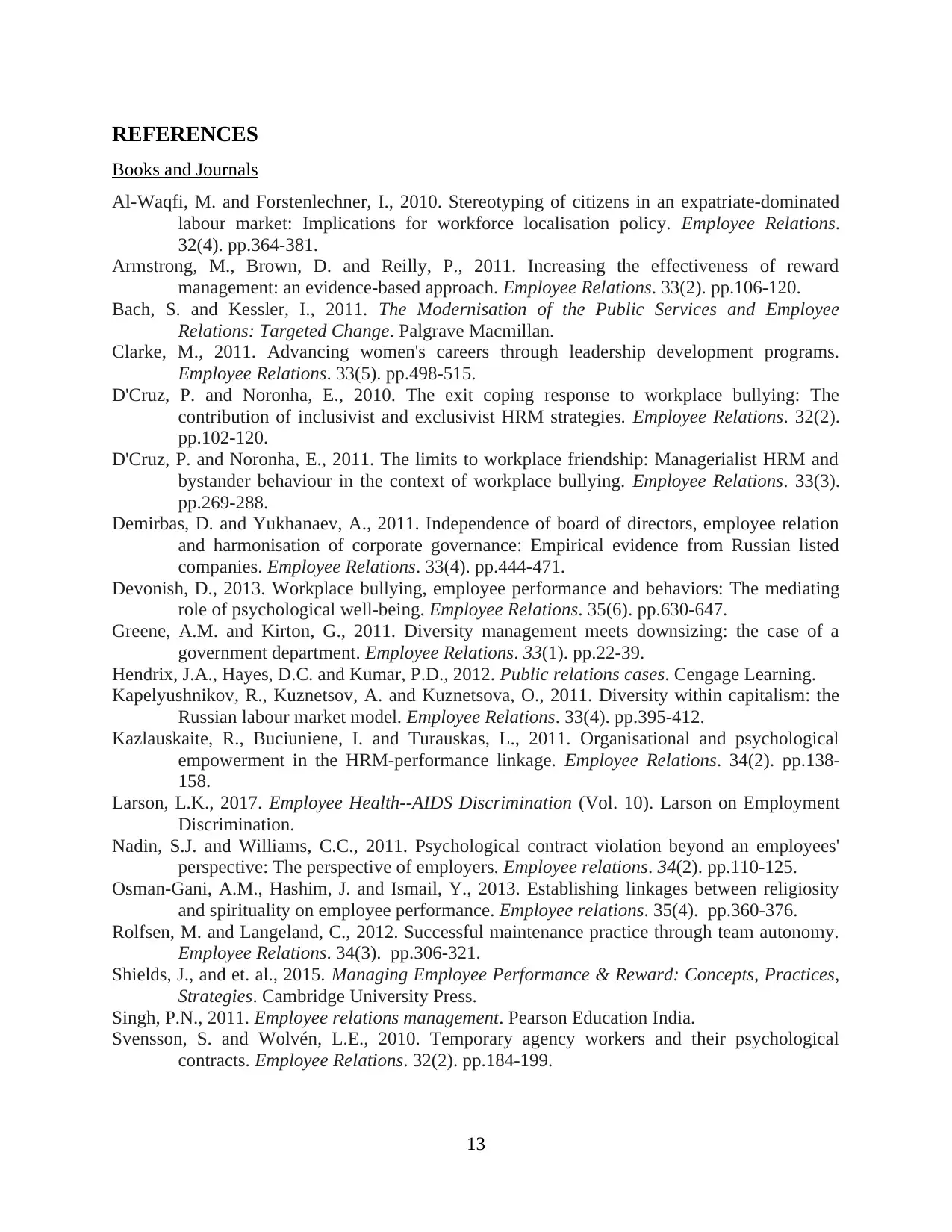
REFERENCES
Books and Journals
Al-Waqfi, M. and Forstenlechner, I., 2010. Stereotyping of citizens in an expatriate-dominated
labour market: Implications for workforce localisation policy. Employee Relations.
32(4). pp.364-381.
Armstrong, M., Brown, D. and Reilly, P., 2011. Increasing the effectiveness of reward
management: an evidence-based approach. Employee Relations. 33(2). pp.106-120.
Bach, S. and Kessler, I., 2011. The Modernisation of the Public Services and Employee
Relations: Targeted Change. Palgrave Macmillan.
Clarke, M., 2011. Advancing women's careers through leadership development programs.
Employee Relations. 33(5). pp.498-515.
D'Cruz, P. and Noronha, E., 2010. The exit coping response to workplace bullying: The
contribution of inclusivist and exclusivist HRM strategies. Employee Relations. 32(2).
pp.102-120.
D'Cruz, P. and Noronha, E., 2011. The limits to workplace friendship: Managerialist HRM and
bystander behaviour in the context of workplace bullying. Employee Relations. 33(3).
pp.269-288.
Demirbas, D. and Yukhanaev, A., 2011. Independence of board of directors, employee relation
and harmonisation of corporate governance: Empirical evidence from Russian listed
companies. Employee Relations. 33(4). pp.444-471.
Devonish, D., 2013. Workplace bullying, employee performance and behaviors: The mediating
role of psychological well-being. Employee Relations. 35(6). pp.630-647.
Greene, A.M. and Kirton, G., 2011. Diversity management meets downsizing: the case of a
government department. Employee Relations. 33(1). pp.22-39.
Hendrix, J.A., Hayes, D.C. and Kumar, P.D., 2012. Public relations cases. Cengage Learning.
Kapelyushnikov, R., Kuznetsov, A. and Kuznetsova, O., 2011. Diversity within capitalism: the
Russian labour market model. Employee Relations. 33(4). pp.395-412.
Kazlauskaite, R., Buciuniene, I. and Turauskas, L., 2011. Organisational and psychological
empowerment in the HRM-performance linkage. Employee Relations. 34(2). pp.138-
158.
Larson, L.K., 2017. Employee Health--AIDS Discrimination (Vol. 10). Larson on Employment
Discrimination.
Nadin, S.J. and Williams, C.C., 2011. Psychological contract violation beyond an employees'
perspective: The perspective of employers. Employee relations. 34(2). pp.110-125.
Osman-Gani, A.M., Hashim, J. and Ismail, Y., 2013. Establishing linkages between religiosity
and spirituality on employee performance. Employee relations. 35(4). pp.360-376.
Rolfsen, M. and Langeland, C., 2012. Successful maintenance practice through team autonomy.
Employee Relations. 34(3). pp.306-321.
Shields, J., and et. al., 2015. Managing Employee Performance & Reward: Concepts, Practices,
Strategies. Cambridge University Press.
Singh, P.N., 2011. Employee relations management. Pearson Education India.
Svensson, S. and Wolvén, L.E., 2010. Temporary agency workers and their psychological
contracts. Employee Relations. 32(2). pp.184-199.
13
Books and Journals
Al-Waqfi, M. and Forstenlechner, I., 2010. Stereotyping of citizens in an expatriate-dominated
labour market: Implications for workforce localisation policy. Employee Relations.
32(4). pp.364-381.
Armstrong, M., Brown, D. and Reilly, P., 2011. Increasing the effectiveness of reward
management: an evidence-based approach. Employee Relations. 33(2). pp.106-120.
Bach, S. and Kessler, I., 2011. The Modernisation of the Public Services and Employee
Relations: Targeted Change. Palgrave Macmillan.
Clarke, M., 2011. Advancing women's careers through leadership development programs.
Employee Relations. 33(5). pp.498-515.
D'Cruz, P. and Noronha, E., 2010. The exit coping response to workplace bullying: The
contribution of inclusivist and exclusivist HRM strategies. Employee Relations. 32(2).
pp.102-120.
D'Cruz, P. and Noronha, E., 2011. The limits to workplace friendship: Managerialist HRM and
bystander behaviour in the context of workplace bullying. Employee Relations. 33(3).
pp.269-288.
Demirbas, D. and Yukhanaev, A., 2011. Independence of board of directors, employee relation
and harmonisation of corporate governance: Empirical evidence from Russian listed
companies. Employee Relations. 33(4). pp.444-471.
Devonish, D., 2013. Workplace bullying, employee performance and behaviors: The mediating
role of psychological well-being. Employee Relations. 35(6). pp.630-647.
Greene, A.M. and Kirton, G., 2011. Diversity management meets downsizing: the case of a
government department. Employee Relations. 33(1). pp.22-39.
Hendrix, J.A., Hayes, D.C. and Kumar, P.D., 2012. Public relations cases. Cengage Learning.
Kapelyushnikov, R., Kuznetsov, A. and Kuznetsova, O., 2011. Diversity within capitalism: the
Russian labour market model. Employee Relations. 33(4). pp.395-412.
Kazlauskaite, R., Buciuniene, I. and Turauskas, L., 2011. Organisational and psychological
empowerment in the HRM-performance linkage. Employee Relations. 34(2). pp.138-
158.
Larson, L.K., 2017. Employee Health--AIDS Discrimination (Vol. 10). Larson on Employment
Discrimination.
Nadin, S.J. and Williams, C.C., 2011. Psychological contract violation beyond an employees'
perspective: The perspective of employers. Employee relations. 34(2). pp.110-125.
Osman-Gani, A.M., Hashim, J. and Ismail, Y., 2013. Establishing linkages between religiosity
and spirituality on employee performance. Employee relations. 35(4). pp.360-376.
Rolfsen, M. and Langeland, C., 2012. Successful maintenance practice through team autonomy.
Employee Relations. 34(3). pp.306-321.
Shields, J., and et. al., 2015. Managing Employee Performance & Reward: Concepts, Practices,
Strategies. Cambridge University Press.
Singh, P.N., 2011. Employee relations management. Pearson Education India.
Svensson, S. and Wolvén, L.E., 2010. Temporary agency workers and their psychological
contracts. Employee Relations. 32(2). pp.184-199.
13
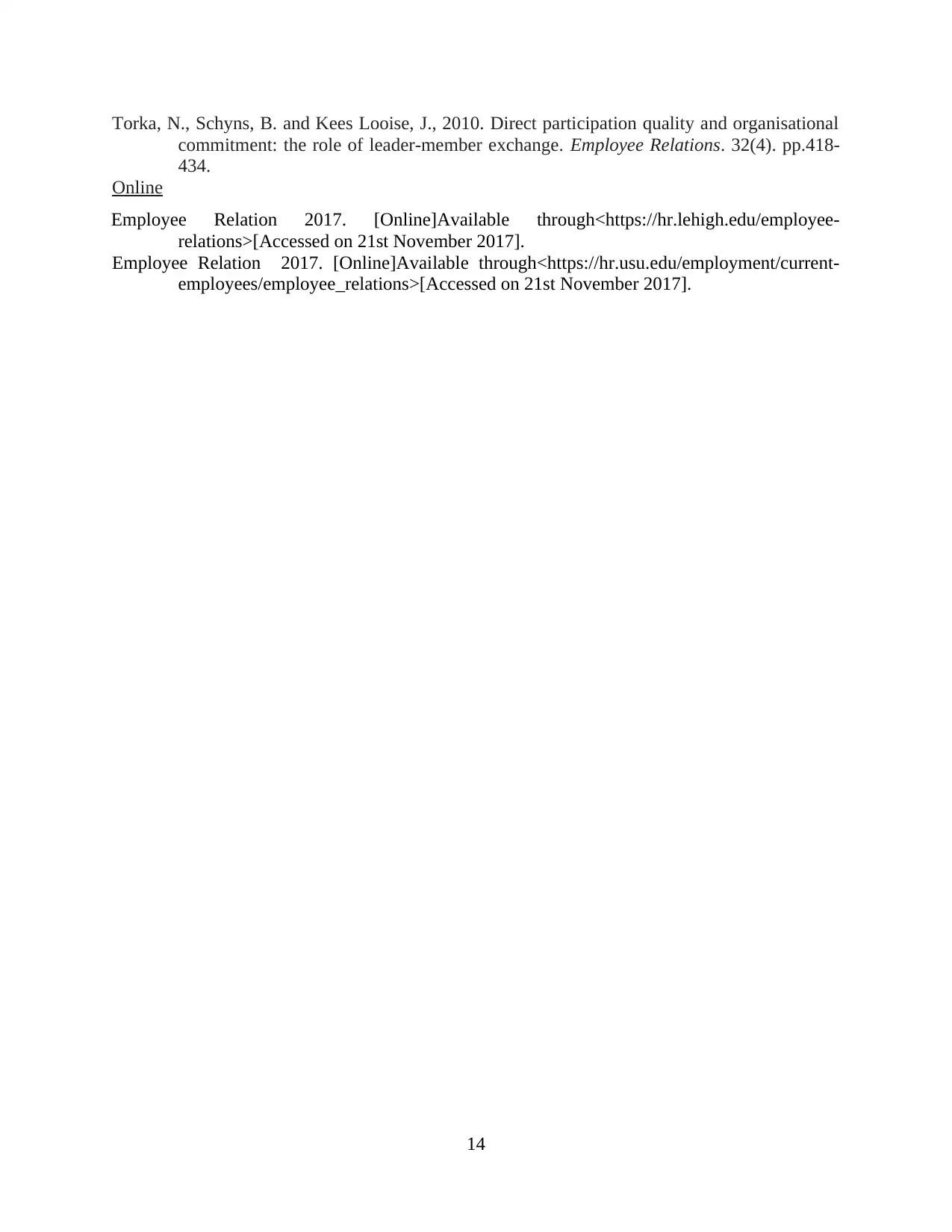
Torka, N., Schyns, B. and Kees Looise, J., 2010. Direct participation quality and organisational
commitment: the role of leader-member exchange. Employee Relations. 32(4). pp.418-
434.
Online
Employee Relation 2017. [Online]Available through<https://hr.lehigh.edu/employee-
relations>[Accessed on 21st November 2017].
Employee Relation 2017. [Online]Available through<https://hr.usu.edu/employment/current-
employees/employee_relations>[Accessed on 21st November 2017].
14
commitment: the role of leader-member exchange. Employee Relations. 32(4). pp.418-
434.
Online
Employee Relation 2017. [Online]Available through<https://hr.lehigh.edu/employee-
relations>[Accessed on 21st November 2017].
Employee Relation 2017. [Online]Available through<https://hr.usu.edu/employment/current-
employees/employee_relations>[Accessed on 21st November 2017].
14
1 out of 16
Related Documents
Your All-in-One AI-Powered Toolkit for Academic Success.
+13062052269
info@desklib.com
Available 24*7 on WhatsApp / Email
![[object Object]](/_next/static/media/star-bottom.7253800d.svg)
Unlock your academic potential
© 2024 | Zucol Services PVT LTD | All rights reserved.





